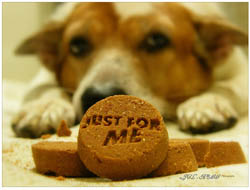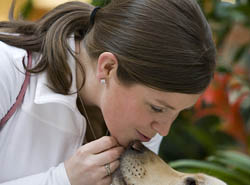Using dog treats for teaching, rewarding good behavior

We teach our dogs by following correct behavior or an approximation of a correct behavior with positive reinforcement. In most cases, that reinforcement is food - a treat.
We teach by luring new behavior that we want from our dogs with treats and by rewarding good behavior with treats.
When the behavior becomes learned, we switch to intermittent
reinforcement, which even more powerful for your dog (much like the
addiction of a slot machine that randomly gives a payout).
This is because your dog no longer knows when she will receive a treat. Therefore treats are a very popular in dog training.
We start with telling our class to use soft treats for their dog. Part of the luring process is rewarding your dog quickly. If you bring dog biscuits to class, your dog will spend time a lot of time crunching the treats and looking on the floor for pieces. We want to reward behavior quickly so your dog begins to understand what we want. Therefore, we ask our classes to bring soft treats.
Pet stores carry a multitude of soft treats. Different flavors, different sizes and many textures of treats are available. We encourage breaking these treats into smaller pieces. Dogs only need a tiny treat to reward their performance.
You can also bring food from home to use as treats. Hotdogs are wonderfully smelly and good treats cut in small pieces. If you make a roast one evening and fat or small bits of meat are left over, then put these in a plastic bag in your freezer and thaw them out for the next class. If you are having chicken for dinner, use leftovers for treats. Many dog trainers swear that nothing trumps chicken. Always when using chicken, beef or fish, make sure there are no bones. Bacon is also a great treat. Fry it, pat it dry it, and cut it into very small pieces. You can also use pre-cooked bacon, which saves you time.
You can also pick up items at the grocery store to use. I am sure everyone has seen the tubes of mozzarella cheese in the dairy section of your store. Cut this string cheese into small circles. In the grocery meat section there is beef liver. You can bake the liver and cut it into small squares. Bake it at 250 degrees for an hour and check it frequently. This is one of the most effective treats I have ever used. Most dogs love cooked liver. It takes a bit longer to prepare, but it is worth it. Most professional handlers at dog shows use their own special recipe of liver as treats. You can find a number of liver and other dog treat recipes at dogaware.com.

If you watch seasoned trainers or professional handlers carefully, you can see that they often put the dog’s treat in their mouths. Taking the treat out of your mouth and giving it to your dog after your dog performs well is a great way to get your dog focused on your face.
Some people even spit it at the dog and have them catch it - another great way to keep the dog’s focus on you. We have put liver in our mouths even though we have never gotten used to the awful taste. (We must add here that we are vegetarians—what we won’t do for our dogs.)
There are many different kinds of treat bags you can purchase to carry your treats in. We call these "bait bags." You can find these in dog catalogs or at your local pet store. The bags are made to attach to your belt or tie around your waist. They are almost pocket size. You can even use a nail bag purchased at a hardware store.
The beauty of the bags is that your treats are so easily accessible. When you put your treats in a plastic bag and put that in your pocket, it will take a while to get a treat to your dog. If you have a bait bag you can just pull a treat out. Timing is everything with luring and treating behavior. If you ask your dog to sit and then you take so much time to get a treat that your dog stands, when you then give that treat to your dog you have now just rewarded a stand.
Most dogs are food motivated, but every so often you will find one that is not. In this case you could use a favorite toy. When your dog performs well, he gets to play with a toy. You can also reward your dog’s behavior with praise and petting.
Dexter residents Bruce and Tracy Willoughby have taught dog training in the area for several years. Click here to read more about them.

